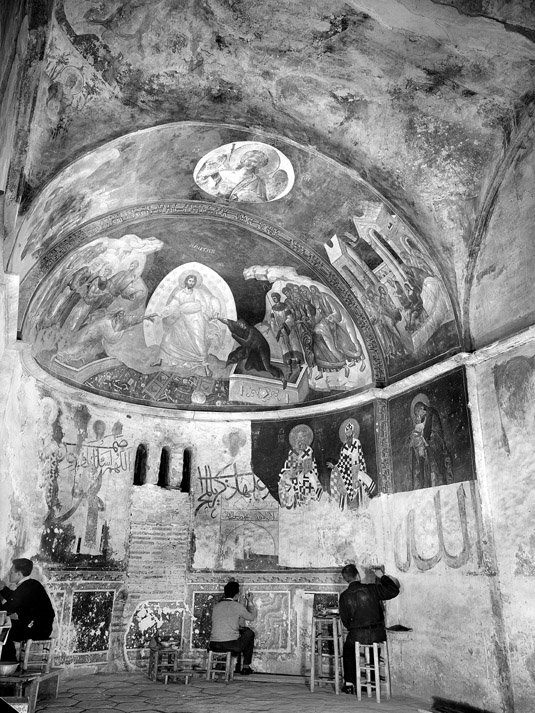Carroll Wales, Part I: “Doctor of Saints”
Byzantine Institute / Kariye Camii / Preservation ARTICLE LINK
Written by Jessica Cebra, ICFA Departmental Assistant
ICFA’s collections are known for its documentation of architecture, mosaics, frescoes and other aspects of material culture from Byzantium, but the actual fieldworkers and skilled craftsmen who worked to restore and conserve these centuries-old buildings and artworks deserve recognition. Here we’d like to highlight the work of Carroll Fenton Wales who was hired by the Byzantine Institute in 1952 and continued to live and work in Istanbul for nine years, specializing in painting conservation.
By the approval of the Directorate General of Museums of the Turkish Republic in 1951, and under the direction of Paul A. Underwood, the Byzantine Institute set out to uncover, clean, restore and conserve the frescoes in Kariye Camii (originally The Church of the Holy Saviour in Chora, and now the Kariye Museum), in Istanbul, which had been plastered and whitewashed over repeatedly to conceal all representational imagery when the Byzantine era church was used as a mosque during the Ottoman period. According to Underwood’s reports, over the years there had been previous ‘crude’ attempts by unknown persons to uncover small areas of the paintings. There was evidence of scraping and the use of knives to break away the crust of the whitewash, as well as superficial and ineffective cleaning techniques. While Ernest J. W. Hawkins, the Assistant Director of the Byzantine Institute, supervised the project, Mr. Carroll Wales was in charge of executing the technical conservation work. Commencing in 1952, the conservation staff was joined by Lawrence J. Majewski and Constantine Tsaousis in 1953, and by Charles Tauss in 1954, who were all known for their skillful and patient work.

Carroll Wales on the far left restoring the frescoes in the parekklesion at Kariye Camii, 1953

The Virgin Eleousa fresco still covered in whitewash with painted Arabic script “Allah,” at Kariye Camii in the parekklesion, 1952

The Virgin Eleousa fresco is revealed in an early stage of whitewash removal, at Kariye Camii, 1952

The Virgin Eleousa after completion of cleaning, repair and conservation, at Kariye Camii, 1955
Extensive photographic documentation of the conservation work at Kariye Camii was provided by Wales himself and is now digitized within ICFA’s collections. Wales donated an additional collection of his color slides to ICFA in the 1990s, which document many other projects he took part in Istanbul and abroad. In the 1960s, he acquired an artwork restoration and conservation business in Boston, called the Oliver Brothers, with his longtime sidekick Constantine Tsaousis, who Wales considered to be “the most outstanding and valuable craftsman.” They ran the business together with an apprentice, restoring numerous artworks and their frames, from all periods and by renowned artists such as John Singleton Copley, Francisco Goya, and Arshile Gorky.

Tsaousis cleaning an icon at Hilandar Monastery, c. 1971, photo by Carroll Wales

Documentation of the cleaning progress of a 17th century icon of The Hospitality of Abraham, Hilandar Monastery, 1972

Removal of icon revetment before cleaning, at Hilandar Monastery, c. 1970
Wales and Tsaousis also continued to work abroad in Spain and Italy. In the 1970s, they had the opportunity to travel to Mount Athos to help restore painted icons in the Hilandar Monastery’s collection. Established in 1198 as a Serbian Orthodox monastery, Hilandar houses over 1,000 icons that have all undergone varying degrees of aging and damage from numerous fires. The monks at Hilandar had heard about Wales’s talent and previous work at Saint Catherine’s Monastery at Mount Sinai and hired him and a team of conservators to repair and restore their collection to its previous unblemished state.

An extreme example of icon damage undergoing cleaning and conservation, at Hilandar Monastery, c. 1970

The 19th century painting before removal to uncover the 12th century icon of The Virgin Akathist beneath, at Hilandar Monastery, c. 1970

Beginning of the removal of the 19th century over-painting of the icon of The Virgin Akathist, at Hilandar Monastery, c. 1970
It is believed that the 12th century icon painting is what the founder of the monastery, Father Sava (first Serbian Archbishop Saint Sava), prayed to at the time. The excitement of the discovery is expressed in Wales’ handwritten notes, which are found with his donated slides and display numerous exclamation marks. The whole painting was uncovered and retouched with the exception of the damaged portion in the lower left corner that couldn’t be salvaged and had to be completely repainted, but this portion can only be seen when the metal revetment frame is removed from the icon. Wales was considered to be a “Doctor of Saints” by one of the Fathers at Mount Sinai. While ICFA doesn’t have much textual documentation of Wales’ work at Mount Athos, we do have a copy of a short recounting he drafted of his time and impressions working at Mount Sinai:
“In my workroom it was very gratifying to make an icon safe by reattaching flaking paint and to set down blisters. Injections of a warm adhesive and gentle pressure of a flat spatula on the Japanese paper that covered the lifted areas made the surface once again flat. Sometimes cleaning was necessary to reveal original colors and details hidden by layers of candle smoke and darkened varnish. Results were often dramatic! One of the Fathers called me Doctor of Saints, another thought I was repainting the icons!”
Wales continued his work at Oliver Brothers until the death of Tsaousis in 1986, when Wales retired from the business. More of their working partnership will be featured here on the ICFA blog in the future, as their immense knowledge of conservation chemistry, their artistry, and pure skills deserve to be more widely known.

The uncovered 12th century icon of The Virgin Akathist, believed to have been prayed to by Father Sava, the founder of the monastery, at Hilandar Monastery, c. 1970
Back to our Fine Art Restoration, Repair & Conservation Services page | or directions to our Studio LINK